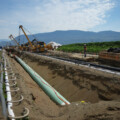The media coverage of Brookfield’s recent proposal to raise a $50 billion self-defined Maple Fund to leverage the assets of Canada’s largest pension funds and the federal government has largely focused on the perceived conflict of interest involving Brookfield chair and Liberal Party of Canada advisor Mark Carney.
Yet putting politics aside, the real question is: are Canadian pension plans investing enough in Canada? If not, is this Maple Fund a good idea?
Canada has the third-largest share of pension wealth globally, despite being the 38th most populous country. Our pension system is strong, well-capitalized, secure, and profitable. Its pension funds are widely regarded around the world as among the most sophisticated and successful institutional investors in their class. Yet for example the Canada Pension Plan only invests 12 percent of its total assets. here in Canada.
Their relatively small investment in Canada isn’t due to unwillingness or a shortage of capital. Instead, there are systemic issues: a lack of entrepreneurial risk-taking in corporate Canada, a concentration of government-owned strategic assets that aren’t for sale, a regulatory environment that stifles growth, and a federal government with an anti-growth agenda.
Canada’s real issue: state capacity, not capital
The notion that a lack of capital is preventing major investments in Canada and that another elite-driven, taxpayer-backed fund is therefore needed, is, to put it simply, misguided.
Research by Keith Amachtsheer, Sebastien Betermier, and Chris Flynn shows that while Canadian pension funds invest in domestic assets like fixed income and real estate, this has been declining over the past decade. But the problem here isn’t a lack of capital or even a lack of patriotism on the part of the country’s institutional investors. It’s primarily due to a lack of available strategic assets in Canada and the increasing attractiveness of returns in other jurisdictions, such as India, New Zealand, and Australia.
Simply put: when large Canadian pension funds, managing trillions of dollars, choose to invest overseas, it reflects poorly on Canada’s domestic economic climate—not the pension funds themselves.
This is where the reports of Brookfield’s proposal make sense: identifying strategic asset classes that present investment opportunities if the federal government allows for privatization. Think for instance of airports or nuclear energy or public utilities or opening up major infrastructure projects in places like Toronto to fair and open tendering. Freeing up such assets could attract capital from Canadian pension funds or other global investors. It’s unclear, however, why taxpayer dollars should be handed to a firm that will take a hefty management fee to buy assets the market would likely invest in if the government opened those opportunities.
Lack of entrepreneurial risk-taking in corporate Canada
Another obstacle to more attractive investment opportunities is the lack of ambition and innovation that characterizes much of Canada’s corporate sector. This has been a key critique from Conservative Party leader Pierre Poilievre. Canadian companies are too often risk averse and in search of government preferences (such as government subsidies or foreign competition restrictions) rather than market-driven innovation.
This risk aversion extends beyond small and medium-sized enterprises to large corporations, many of which are insulated from competitive pressures due to monopolistic or oligopolistic market structures. Far too many are focused on preserving the status quo rather than creating new economic value. In fact, analysis in The Hub demonstrates that the median founding year of the top 15 largest companies by market cap on the TSX was 1899.
Brookfield’s Maple Fund, while a promising attempt to spark domestic investment, does little to address this lack of entrepreneurial culture. Canada needs a new generation of corporate leaders willing to take bold risks and foster innovation. The question isn’t why we don’t have more funds like the Maple Fund, but why we don’t have more companies like Shopify. In fact, Shopify’s co-founder, Tobi Lutke, expressed a similar sentiment in a podcast with American economist Tyler Cowen, arguing that Canada’s corporate and founder culture lacks the ambition found in the United States. This shortfall isn’t due to the lack of another government-backed fund, but rather a lack of risk-taking and hyper-competitive instincts at the executive level in many of Canada’s leading corporations.
Regulatory barriers to investment and growth
In addition to a risk-averse corporate culture, Canada’s regulatory framework is a major obstacle to investment and growth. Key industries, from telecommunications to energy, face extensive regulatory hurdles that slow projects, add unnecessary costs, and dissuade capital inflows. This regulatory environment stifles competition and discourages innovation by creating high barriers to entry for new players. It’s notable for instance that the OECD cites Canada as among the slowest jurisdictions among its members for project approvals and last in productivity growth over the 2030-60 timeframe. .
Brookfield’s proposal purportedly includes investments in heavily regulated sectors like telecommunications, housing, and public infrastructure. Yet capital flows aren’t the real problem here. The bureaucratic and regulatory obstacles that make it difficult to execute projects efficiently and profitably are. This is particularly evident in Canada’s housing crisis, where supply cannot keep pace with rising demand. Without sweeping land-use reform across the provinces and key cities, the Maple Fund would invariably find itself bogged down by the very environment it seeks to invigorate.
The key point is that policymakers need to diagnose the right cause of the problem. Regulatory reform, not a new fund, would unlock the potential for Canadian pension funds to invest domestically as they already do in places like India, New Zealand, and Australia.
The federal government’s anti-growth agenda
Perhaps the most pressing issue is the role of the federal government in shaping Canada’s economic future. Despite its rhetoric of encouraging investment in infrastructure, clean energy, and housing, the Trudeau government’s policies have often contradicted these goals. High taxes, excessive regulation, and policies that prioritize environmental or social objectives over economic growth have contributed to an anti-growth climate in Canada.
High immigration numbers may artificially inflate demand, but GDP per capita is declining, and the productivity gap between Canada and the United States is widening. The underlying state of Canada’s investment climate isn’t good.
Take just one example: the Trudeau government’s controversial Bill C-69, which overhauled the environmental assessment process for major projects, has hindered growth in Canada’s resource sector by increasing costs, extending timelines, and reducing investor confidence. This in turn has led capital to seek more favourable investment opportunities abroad.
It must also be said that the federal government’s proposed involvement in the Maple Fund raises concerns about potential political interference. Ottawa’s $10 billion investment would likely come with strings attached, subjecting the fund to political whims. Rather than facilitating growth, government involvement in the Maple Fund could exacerbate the bureaucratic and regulatory barriers that already inhibit investment. And that doesn’t even account for Carney’s possible role.
A call for structural reform
Canada doesn’t have a capital problem—it has a state capacity problem. The country has ample financial resources to fund major infrastructure and innovation projects. What it lacks is a business environment that encourages risk-taking, a regulatory framework that fosters competition and growth, and a federal government focused on economic expansion over political agendas.
To unlock Canada’s economic potential, policymakers must therefore focus on the root causes of the problem rather than merely its symptoms. We need a dedicated policy agenda to make the economy more attractive to capital, including from Canadian pension funds.










